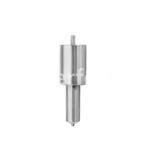Information injection-pump assembly
BOSCH
F 01G 09U 033
f01g09u033
ZEXEL
101601-5991
1016015991
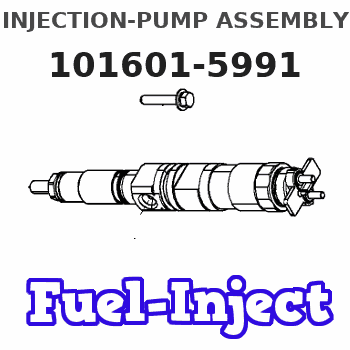
Rating:
Service parts 101601-5991 INJECTION-PUMP ASSEMBLY:
1.
_
7.
COUPLING PLATE
8.
_
9.
_
11.
Nozzle and Holder
23600-2133
12.
Open Pre:MPa(Kqf/cm2)
19.6{200}
15.
NOZZLE SET
Include in #1:
101601-5991
as INJECTION-PUMP ASSEMBLY
Include in #2:
104138-4001
as _
Cross reference number
BOSCH
F 01G 09U 033
f01g09u033
ZEXEL
101601-5991
1016015991
Zexel num
Bosch num
Firm num
Name
Calibration Data:
Adjustment conditions
Test oil
1404 Test oil ISO4113 or {SAEJ967d}
1404 Test oil ISO4113 or {SAEJ967d}
Test oil temperature
degC
40
40
45
Nozzle and nozzle holder
105780-8140
Bosch type code
EF8511/9A
Nozzle
105780-0000
Bosch type code
DN12SD12T
Nozzle holder
105780-2080
Bosch type code
EF8511/9
Opening pressure
MPa
17.2
Opening pressure
kgf/cm2
175
Injection pipe
Outer diameter - inner diameter - length (mm) mm 6-2-600
Outer diameter - inner diameter - length (mm) mm 6-2-600
Overflow valve
134424-0920
Overflow valve opening pressure
kPa
162
147
177
Overflow valve opening pressure
kgf/cm2
1.65
1.5
1.8
Tester oil delivery pressure
kPa
157
157
157
Tester oil delivery pressure
kgf/cm2
1.6
1.6
1.6
Direction of rotation (viewed from drive side)
Right R
Right R
Injection timing adjustment
Direction of rotation (viewed from drive side)
Right R
Right R
Injection order
1-4-2-6-
3-5
Pre-stroke
mm
3.8
3.77
3.83
Beginning of injection position
Drive side NO.1
Drive side NO.1
Difference between angles 1
Cal 1-4 deg. 60 59.75 60.25
Cal 1-4 deg. 60 59.75 60.25
Difference between angles 2
Cyl.1-2 deg. 120 119.75 120.25
Cyl.1-2 deg. 120 119.75 120.25
Difference between angles 3
Cal 1-6 deg. 180 179.75 180.25
Cal 1-6 deg. 180 179.75 180.25
Difference between angles 4
Cal 1-3 deg. 240 239.75 240.25
Cal 1-3 deg. 240 239.75 240.25
Difference between angles 5
Cal 1-5 deg. 300 299.75 300.25
Cal 1-5 deg. 300 299.75 300.25
Injection quantity adjustment
Adjusting point
A
Rack position
9.7
Pump speed
r/min
1250
1250
1250
Average injection quantity
mm3/st.
102.9
100.9
104.9
Max. variation between cylinders
%
0
-3.5
3.5
Basic
*
Fixing the lever
*
Injection quantity adjustment_02
Adjusting point
-
Rack position
6.1+-0.5
Pump speed
r/min
650
650
650
Average injection quantity
mm3/st.
10
9
11
Max. variation between cylinders
%
0
-10
10
Fixing the rack
*
Remarks
Adjust only variation between cylinders; adjust governor according to governor specifications.
Adjust only variation between cylinders; adjust governor according to governor specifications.
Injection quantity adjustment_03
Adjusting point
C
Rack position
-
Pump speed
r/min
100
100
100
Average injection quantity
mm3/st.
109
101
117
Fixing the lever
*
Remarks
After setting SM.. rack limit
After setting SM.. rack limit
Timer adjustment
Pump speed
r/min
1100--
Advance angle
deg.
0
0
0
Remarks
Start
Start
Timer adjustment_02
Pump speed
r/min
1050
Advance angle
deg.
0.5
Timer adjustment_03
Pump speed
r/min
1250
Advance angle
deg.
2
1.5
2.5
Remarks
Finish
Finish
Test data Ex:
Governor adjustment
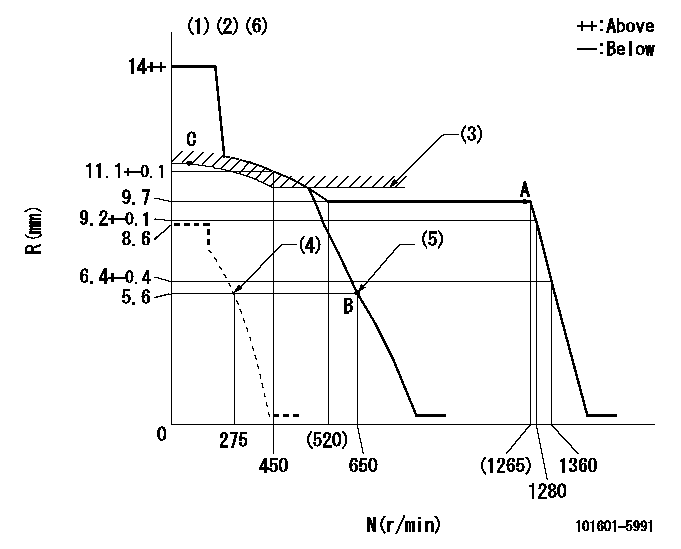
N:Pump speed
R:Rack position (mm)
(1)Target notch: K
(2)Tolerance for racks not indicated: +-0.05mm.
(3)SMA RACK LIMIT; RAL (at N = N1)
(4)Set idle sub-spring
(5)Main spring setting
(6)Perform governor adjustment at an ambient temperature of at least 15 deg C (rack limit spring is shape memory alloy).
----------
K=14 RAL=10.4+0.2mm N1=400r/min
----------
----------
K=14 RAL=10.4+0.2mm N1=400r/min
----------
Speed control lever angle
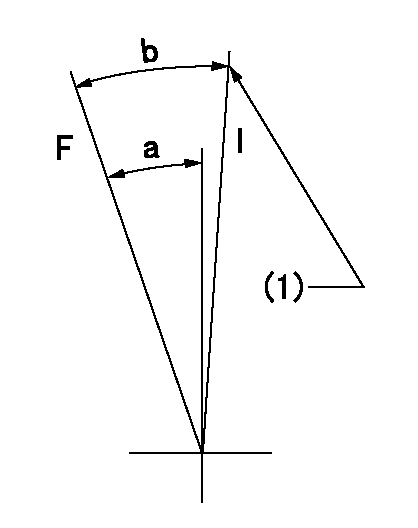
F:Full speed
I:Idle
(1)Stopper bolt setting
----------
----------
a=17deg+-5deg b=19deg+-5deg
----------
----------
a=17deg+-5deg b=19deg+-5deg
Stop lever angle
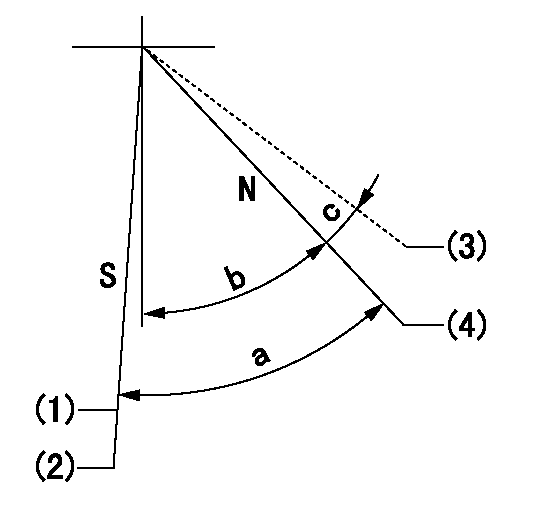
N:Pump normal
S:Stop the pump.
(1)Normal stop
(2)Rack position aa or less, pump speed bb
(3)Contacts normal side pin
(4)Clearance from the pin on the normal side: cc
----------
aa=5.1mm bb=0r/min cc=2.5+-0.5mm
----------
a=53deg+-5deg b=51deg+-5deg c=(6deg)
----------
aa=5.1mm bb=0r/min cc=2.5+-0.5mm
----------
a=53deg+-5deg b=51deg+-5deg c=(6deg)
Timing setting
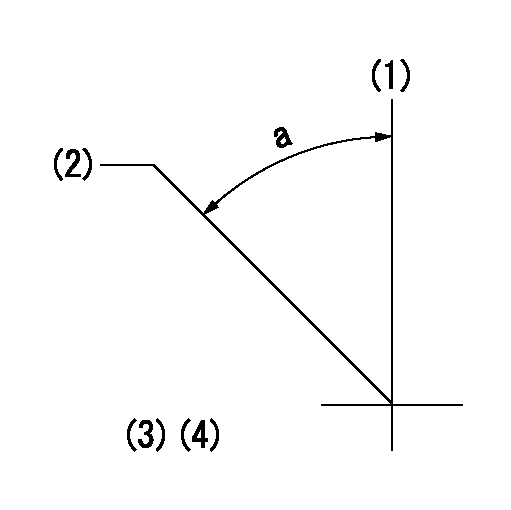
(1)Pump vertical direction
(2)Coupling's key groove position at No 1 cylinder's beginning of injection
(3)-
(4)-
----------
----------
a=(50deg)
----------
----------
a=(50deg)
Information:
Cooling System
Clean/Flush Coolant
Do not perform this maintenance until you read and understand the material in the Safety and Cooling System Specifications sections of this publication. This procedure is to be used for normal maintenance of cooling system surfaces to return to "like new" condition. For heavy build-up of scale and deposits, a severe acid-type, commercial cleaner or mechanical cleaning will be required.
1. Stop the engine and allow to cool. Loosen the radiator filler cap slowly and remove the cap to relieve pressure. 2. Remove the cooling system drain plug(s). Remove the drain plug (1) on bottom of water pump housing and/or radiator.Check water pump breather filter 4N1400 (2) for blockage or debris and replace if necessary.
Right Side View3. Open the cab heater valve to flush coolant from the cab heater. Remove the two block drain plugs from both sides of the engine. Allow coolant to drain.With the recent shortage and higher cost of new antifreeze and the disposal problems of used engine coolant, the interest in recycling the used engine coolant has sharply increased. Various methods have been proposed to reclaim used coolant for reuse in engine cooling systems.Filtering methods for reclaiming the used engine cooland do not reduce the level of chemicals in the water. The full distillation procedure is the only method acceptable by Caterpillar to reclaim the used coolant. The ethylene glycol and water obtained from this process can be treated with new chemical corrosion inhibitors to provide a like-new coolant.Commercial units are available to do this distillation process. Contact Caterpillar Service Technology Group: Outside Illinois: 1-800-542-TOOL Inside Illinois: 1-800-541-TOOL Canada: 1-800-523-TOOLRefer to Service Magazine article dated November 13, 1989 and/or Engine News article dated November 1989 for information regarding disposal and recycling of used coolant.4. Clean and install all drain plugs or close the drain valve. Refill the cooling system with clean water mixed with a 6 to 10 percent concentration of Caterpillar Cooling System Cleaner. Install radiator filler cap.Caterpillar Cooling System Cleaner is available through your Caterpillar dealer. A 9-12 gallon (33-47 L) cooling system capacity requires one gallon (3.8 L) of Caterpillar Cooling System Cleaner to accommodate the 6-10 percent concentration.5. Start and run the engine to circulate fluid in the cooling system for 1 1/2 hours.6. Stop the engine, remove radiator filler cap and cooling system drain plugs.7. Drain the cleaning solution. Flush the cooling system with clean water until draining water is clear. Clean and install all drain plugs and/or close the drain valve.8. Mix a solution of acceptable water and Caterpillar Antifreeze (which contains supplemental coolant additive). If NOT using Caterpillar Antifreeze, add 1 U.S. quart (1 L) of Caterpillar Supplemental Coolant Additive for every 8 U.S. gal (30 L) of cooling system capacity OR replace maintenance element with a precharge element only. Supplemental Coolant Additive or a coolant additive element (if equipped) should only be used when NOT refilling cooling system with Caterpillar Antifreeze. Refer to the topic Cooling System Specifications in this publication for all information regarding
Clean/Flush Coolant
Do not perform this maintenance until you read and understand the material in the Safety and Cooling System Specifications sections of this publication. This procedure is to be used for normal maintenance of cooling system surfaces to return to "like new" condition. For heavy build-up of scale and deposits, a severe acid-type, commercial cleaner or mechanical cleaning will be required.
1. Stop the engine and allow to cool. Loosen the radiator filler cap slowly and remove the cap to relieve pressure. 2. Remove the cooling system drain plug(s). Remove the drain plug (1) on bottom of water pump housing and/or radiator.Check water pump breather filter 4N1400 (2) for blockage or debris and replace if necessary.
Right Side View3. Open the cab heater valve to flush coolant from the cab heater. Remove the two block drain plugs from both sides of the engine. Allow coolant to drain.With the recent shortage and higher cost of new antifreeze and the disposal problems of used engine coolant, the interest in recycling the used engine coolant has sharply increased. Various methods have been proposed to reclaim used coolant for reuse in engine cooling systems.Filtering methods for reclaiming the used engine cooland do not reduce the level of chemicals in the water. The full distillation procedure is the only method acceptable by Caterpillar to reclaim the used coolant. The ethylene glycol and water obtained from this process can be treated with new chemical corrosion inhibitors to provide a like-new coolant.Commercial units are available to do this distillation process. Contact Caterpillar Service Technology Group: Outside Illinois: 1-800-542-TOOL Inside Illinois: 1-800-541-TOOL Canada: 1-800-523-TOOLRefer to Service Magazine article dated November 13, 1989 and/or Engine News article dated November 1989 for information regarding disposal and recycling of used coolant.4. Clean and install all drain plugs or close the drain valve. Refill the cooling system with clean water mixed with a 6 to 10 percent concentration of Caterpillar Cooling System Cleaner. Install radiator filler cap.Caterpillar Cooling System Cleaner is available through your Caterpillar dealer. A 9-12 gallon (33-47 L) cooling system capacity requires one gallon (3.8 L) of Caterpillar Cooling System Cleaner to accommodate the 6-10 percent concentration.5. Start and run the engine to circulate fluid in the cooling system for 1 1/2 hours.6. Stop the engine, remove radiator filler cap and cooling system drain plugs.7. Drain the cleaning solution. Flush the cooling system with clean water until draining water is clear. Clean and install all drain plugs and/or close the drain valve.8. Mix a solution of acceptable water and Caterpillar Antifreeze (which contains supplemental coolant additive). If NOT using Caterpillar Antifreeze, add 1 U.S. quart (1 L) of Caterpillar Supplemental Coolant Additive for every 8 U.S. gal (30 L) of cooling system capacity OR replace maintenance element with a precharge element only. Supplemental Coolant Additive or a coolant additive element (if equipped) should only be used when NOT refilling cooling system with Caterpillar Antifreeze. Refer to the topic Cooling System Specifications in this publication for all information regarding
